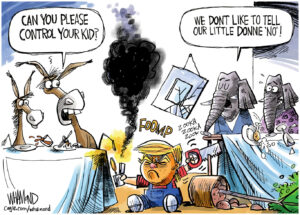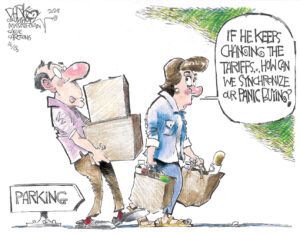U.S.-China Talks Are About Much More Than Trade
Trump continues to shine a path for the GOP next year in crucial Rust Belt states—especially if Dems stick with the “free trade” mantra. China's President Xi Jinping speaks during the opening ceremony of the G-20 Summit in Hangzhou, China, on Sept. 4, 2016. (Mark Schiefelbein / AP)
China's President Xi Jinping speaks during the opening ceremony of the G-20 Summit in Hangzhou, China, on Sept. 4, 2016. (Mark Schiefelbein / AP)
This article was produced by Economy for All, a project of the Independent Media Institute.
Just when it appeared that Washington and Beijing were inching closer to concluding their trade negotiations (thereby bringing a cessation in the ongoing and escalating conflict), the U.S. president has thrown a new grenade in China’s direction. Trump “threatened to raise tariffs on all Chinese imports to 25 per cent, sharply ratcheting up pressure on Beijing to make concessions in trade talks and sending global equities markets sliding,” write James Politi, Courtney Weaver, Tom Mitchell and Yuan Yang of the Financial Times.
Win or lose, anything that creates the perception that the administration is standing up for the rights of American workers (even at a cost of repudiating decades of free trade ideology) could cement Trump’s growing popularity within a traditional Democratic Party constituency. Many blue-collar voters tried to send a message of change in 2016 when they voted for Trump. These voices are particularly germane in Midwestern states, which basically secured the necessary Electoral College votes required to put Trump in the White House.
Politics aside, the trade talks create dilemmas for both sides: capital markets in both countries have revived, as expectations have grown that the two nations would resolve this increasingly acrimonious dispute, albeit on terms that largely retain the status quo.
Trump in particular has done much to elevate those expectations in his Twitter account, even as it became increasingly apparent that the nature of the deal was unlikely to do anything more than induce Beijing to make further large-scale purchases of American exports, as opposed to undertaking structural reforms of the kind that would likely rectify some longstanding U.S. grievances, such as the appropriation of intellectual property (IP), cyber-theft, and inadequate access to Beijing’s domestic markets, to cite a few prominent examples.
Similarly, President Xi Jinping is looking for a deal that gets rid of the tariffs and avoids a new shock to a Chinese economy, which is now recovering from last year’s tariff-induced trauma via a significant new credit provision from the government.
The problem, as Trump seems to appreciate (albeit belatedly, if one is to judge from the timing of his latest tweet storms), is that he can’t afford to be perceived as weak on trade. It’s been one of his signature issues since his 2016 campaign. But confronting Beijing on the structural issues, and concomitantly causing a breakup of the supply chains that are the foundation of today’s “Chimerica” nexus, likely entails creating transitory economic dislocation in the United States (as well as further major setbacks in the stock market), hardly the sort of thing that the U.S. president would like to see happen in the run-up to the 2020 election campaign. As New York magazine’s Intelligencer columnist Josh Barro starkly puts it:
“One, [Trump] wants to be seen to be ‘tough’ on China trade, and two, he wants the stock market to go up. The problem is, the stock market hates trade wars, and when the president threatens (or actually imposes) higher tariffs on Chinese goods, stock prices fall.”
Any dislocation, financial or economic, would also constitute a political gift to the Democrats.
So the essence of the conundrum is this: is Trump willing to take a short-term hit among certain traditional GOP constituencies in order to secure the longer-term changes that his chief U.S. trade adviser, Robert Lighthizer, has long advocated as essential to preserve the livelihoods of American workers? Not only is there a political hit, but the very magnitude of the potential retaliation Trump and Lighthizer have proposed—vastly increased tariffs, along with the aggressive use of various World Trade Organization (WTO) sanctions to counter Beijing—also constitutes a repudiation of over half a century of American trade policy and ideology, as well as disrupting traditional political alliances with key Republican constituencies.
In regard to the latter, Trump’s actions could well herald the start of a major political realignment. This may already be starting. In response to the Republican Party’s increasing embrace of Trumpian-style populism, for example, the U.S. Chamber of Commerce is now looking to “disentangle its brand from the GOP,” writes the Washington Post. It has spoken about rebuilding the center, ironically echoing the language of the self-proclaimed progressive, Speaker of the House Nancy Pelosi, who has similarly warned Democrats to hew to the center in order to beat Trump next year. Barring a Sanders or Warren nomination, therefore, the Democrats could well find themselves with an unlikely new champion in the form of a Chamber of Commerce endorsement next year.
This wouldn’t trouble many of the non-traditional Republicans, who currently dominate trade policy in the administration. As far as trade itself goes, Trump seems to be inching toward the kind of right-wing populism initially advocated by figures like Steve Bannon and self-proclaimed “blue collar conservatives,” such as Rick Santorum or Pat Buchanan. These figures (and many others) have long sought to reconfigure the GOP as the party for American workers, even at a cost of closing off portions of the American economy via protectionism, if it means more jobs at home for U.S. workers. Rightly or wrongly, this kind of political recalibration could well be one of the by-products of the prospective trade agreement with China. It would therefore have significant electoral implications in 2020, where the Midwest Rust Belt is likely to remain the key battleground region that will likely determine the winner of the presidency.
On the other hand, even if the talks do break down (this now appears more likely), and Trump follows through on his threat to raise tariffs on all Chinese goods to 25 percent, such overt protectionism could well reinforce the GOP’s working-class support, especially if such tariffs are accompanied by other forms of direct state intervention and more restrictionist immigration policies that would structurally tighten up the labor market (and enhance workers’ bargaining power as a result). True, a stock market fall could well hurt those at the top tier, but that could actually reinforce the optics of Trump’s populist message if he simply makes the case that he is going to the mat for U.S. workers, even if means some short-term pain for the investor class.
The corollary also could work toward furthering this realignment: if the Democrats were to nominate an old guard “Free Trade” candidate who represented a proxy for the status quo ante, one who still largely champions standard trade agreements of the kind secured over the past 40 years or so (such as current front-runner Joe Biden), this could well widen the political gap between the Democratic Party and some of its historically loyal constituencies.
Even if Trump settles for a traditional bilateral deal in which Beijing pledges to buy more U.S. goods, it could well catalyze this political reconfiguration to the extent that it reinforces his “America First” nationalism vs. the traditional multilateral liberal order that is perceived as more friendly to existing American elites. Why? Because one outcome of a U.S.-China trade agreement is that it will likely penalize some of Beijing’s other major trade partners if China’s ultimate concessions simply redistribute purchases away from other countries (e.g., Brazil, which is also a major exporter of soybeans to China, or member states of the European Union). A new bilateral U.S.-China trade deal could also increasingly marginalize the World Trade Organization, particularly if (as is rumored) the agreement contains bilateral resolution provisions that effectively sideline the multilateral trade body, as well as disrupting today’s global supply chains that, as the Financial Times’ Edward Luce argues, are largely predicated on the existence of a stable trade regime with a clearly defined set of politically neutral regulations.
That would be political gold to Trump, and his America First agenda. In fact, it will likely be a feature of any proposed new agreement rather than a bug. Both Trump and Lighthizer are keen to re-domicile as many manufacturing supply chains as possible back to the American heartland (which also happens to be one of the key constituencies of Trump’s base, the multi-decade losers of globalization, whose concerns have traditionally been ignored by both parties, except during election season). If this antagonizes America’s traditional trade partners, so be it. Trump has not hitherto proven himself to be particularly solicitous to the views of Washington’s historic friends and allies.
Of course, all of this posturing by Trump may be another sign of the proverbial carnival barker at work, but in the absence of a compelling alternative narrative from the Democrats, it could well prove to be a powerful elixir in the president’s efforts to secure a second term in office.
Your support is crucial...As we navigate an uncertain 2025, with a new administration questioning press freedoms, the risks are clear: our ability to report freely is under threat.
Your tax-deductible donation enables us to dig deeper, delivering fearless investigative reporting and analysis that exposes the reality beneath the headlines — without compromise.
Now is the time to take action. Stand with our courageous journalists. Donate today to protect a free press, uphold democracy and uncover the stories that need to be told.






You need to be a supporter to comment.
There are currently no responses to this article.
Be the first to respond.